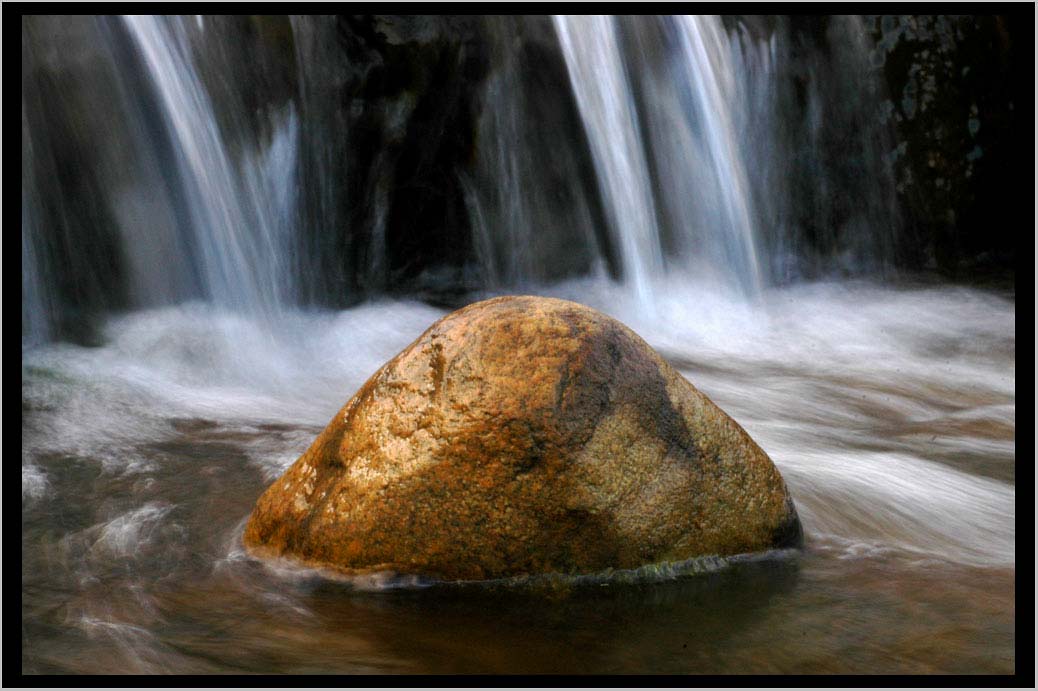

Rock with Flowforms . . . [ click photo for next . . . ]
On the road in the American Northwest.


Rock with Flowforms . . . [ click photo for next . . . ]
On the road in the American Northwest.
Water in flowing movement is at the center of my work,
of what I do. Every time I pack out of the high country
and come down to my Office, the first thing I miss
is the sound of rushing water. For me, it is the sound
which holds all other sounds.
But then, there's also this question of movement. And
the key relationship between form and movement. This
is, I think, what flowing water shows us:
Form is the outward envelope
of the rhythmic pulse of change.
This is on of those things I've been repeating over
and over again for thirty years, and even with close
friends, eliciting the same blank, somewhat confused
look. As if to say, "What's he talking about?"
Well, it's simple. Movement is primary; form, secondary.
That means, in poetry, it's understanding the flow of
sound and meaning as heard that's vitally important.
Not the eye-dominated universe—an illusion, really—
of the academy's printed page. [see my Understanding
the Shape of Change: 12 primary concepts in the
description and generation of movement in music,
poetry and dance | pdf ] And that means, in music,
many of what were considered crucial problems of
the 20th Centruy, like a-tonality, or a-periodicity,
to name two arcane concepts, are no longer relevant.
What is essential, again, is movement. So we think
then differently, in a much more general, and in my
view, powerful, way. Instead of tonality, we think
in terms of centers, simplicty/complexity cycles,
and especially, difference and complementarity.
[see my Difference: Once there is difference, there
is complementarity. Once there is complementarity,
there is movement. Art happens in the balance
thereby created. pdf ]
Remarkably, this is true, I believe, for the 'still'
image, as well. hi
Eagle Cap Wilderness . . .
FALL-BACK!
With all fundamental change, we should prepare ourselves for what I
think of as fall-back. This is a sudden slide back into an old habit of
thought and action.
Say, I quit smoking. Then one dark and rainy day, in a moment of
weakness, someone offers me a cigarette, and I’m right back in the old
groove again. Or, we decide to take apart at great cost the horrendous
mistake of atomic energy, and begin the complicated task of get-
ting rid of all the hazardous waste. Then one thoughtless day, oil and
electricity prices soar, and suddenly we want to turn the reactors back
on again. (This is actually taking place in Holland and Germany
as I write this (2008), and made very much worse by the confused and
confusing rhetoric and, in my view, false promise of so-called third
and fourth generation (fast breeder) reactors.)
[see my whitebark—BLOG: from DECEMBER 2010
WHY I LOVE / HATE HANSON’S
STORMS OF MY GRANDCHILDREN ]
The transition is typically from old to new, from an old regime or pat-
tern of movement—and way of seeing and thinking—to a new, bet-
ter, healthier one. This process or period of change from one state to
another should have a special name. It is always an exacting, exciting
time, alive with new challenges. But it is also a vulnerable, tender
time, like spring, in which new, emerging growth can be frozen dead in
an instant with the return and harsh indifference of a late winter’s frost.
But see the reddish tinge on many new shoots and leaves. It’s natural
‘antifreeze,’ Nature’s way of protecting new growth during the transi-
tion time from high-country spring to summer. We would do well, I
think, to mimic the wisdom of this kind of just-in-case protection.
This tendency to fall back is made very much worse by those who for
whatever reason do not wish to go along with fundamental change. In
the shadow cast by real innovation’s forward momentum, there will al-
ways be those who remain doggedly committed to the old, outmod-
ed technologies, like nuclear energy and fossil fuels, perhaps because
of some special, vested interest. Or because a knowledge base is still
widely available, and a generation or two of highly trained technicians
are still eager to continue the old way of doing things. It’s only to be ex-
pected. But from the wider perspective, these are just natural, temporary
slips on the bright, if sometimes difficult path, of progressive change.
HERE
On the way,
many beautiful camps
offer themselves for the night.
But to know,
when to keep walking and
when to stay,
and, after stopping,
to know without a doubt
that this place, where one stands,
here,
I am at home.
Hummingbird Pass,
Eagle Cap Wilderness,
Oregon, X.29.2008
FALL-BACK! and HERE are part of
THE LITTLE CLAVIER please preview 150 of 631 pages
w/ my black & white photography [opens in new window]
Let me know what you think!
NEW: To view / purchase high quality prints & matted frames
at the Photoweek Northwest online store, SLIDESHOW
http://picturepoems.zenfolio.com/
All Photographs & texts by Cliff Crego © 2011 picture-poems.com
(created: X.11.2008)